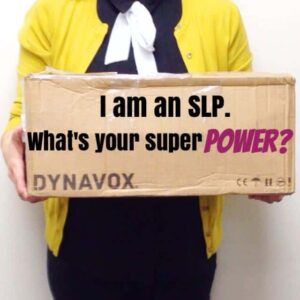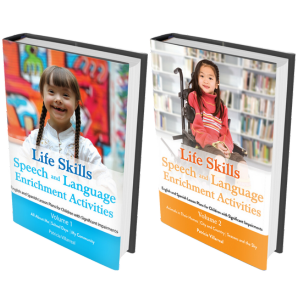I Have No Idea What I’m Doing
I promise I’m an SLP. There are two diplomas tucked away in my garage to prove it. I know the answers to questions. Sometimes. I can talk about language, social skills and articulation for days. Ask me something about Augmentative and Alternative Communication or Assistive Technology (AAC and AT), and you will likely watch me quietly sitting (and avoiding eye contact). Here’s the thing. As SLPs, we do not have all of the answers, and it’s okay. Once you give kindness to yourself, you still need to do your job. Don’t worry. I’ll show you how.
Right now, I am working with two young men in their twenties. Both gentlemen had communication devices throughout school; however, upon graduation, the devices were no longer available to them. Based on the evaluations, I know both can benefit and improve their functional communication with a functional mode of communication.
7 Tips for AAC and AT
- Transparency: I communicated to the clients and their parents that they need AT to support their communication needs. This is a no-brainer for an SLP. Then, I told them I was unsure of how to exactly do this. I was honest, and I let them know I would work hard to find the answers. Trust was built.
- Reach Out To SLP-Friends: I am not an expert in all areas of speech-language pathology. However, I have SLP and teacher friends (the best kind!) who have awesome brains. So, I started calling and emailing. Lo and behold, with some help, I figured it out.
- Texas Technology Access Program: This program has been a life-saver for me. Their mission is to increase access for people with disabilities to Assistive Technology that provides an enhanced ability to function independently. You complete a short form online, choose from a long list of available devices and, if available, the device is loaned to you for 30 days or more (can be renewed if no one is waiting for it). Denise runs the show, and she will kindly answer all questions with passion and a smile. The device is mailed to you or your client with returned packaging and postage. Easy-peasy.
- Specialized Telecommunications Assistance Program (STAP): This program is set up through the Texas Department of Assistive and Rehabilitative Services (DARS). The goal is to get individuals access to the telephone system. And, this means that, for some individuals, they need a speech generating device to be able to communicate. You complete a form, turn it in, and, if approved, you are given a voucher for a device. Right now, I have requested an ipad with a Dynovox Tobii Compass app for my client. Fingers-crossed we are approved!
- Texas Department of Assistive and Rehabilitative Services (DARS): For those who receive services from DARS, there is also a possibility that a communication device can be obtained for the purposes of gaining employment. I communicated with my client’s counselor, turned in my speech and language evaluation and spoke with one of DARS’-approved vendors (they have the devices). Voilà, we should be getting our ipad, Dynovox Tobii Compass app and the First, Then app in a few weeks.
- Gridplayer App: So, with all worthwhile things, my clients and their families are waiting. In the meantime, I still need to keep on SLPing (it’s surely a verb). So, we are using this free AAC app to communicate. And, you know what? It gets the job done pretty well.
- Get Schooled: As for me, I need to up my AAC and AT game. So, I am learning. There are many places that have online trainings that you can do at home: ASHA, Prentke Romich. There are also some great SLP bloggers already doing the work for us. I especially appreciate PrAACtical AAC and Speech Techie .
The process has not been pretty, but it’s been good. And, at the end of the day, I have been a part of a young man’s journey to getting his voice heard. That, folks, is pretty darn cool.







Good for you, stoked SLP! As an SLP for 30 years now, I’ve been amazed at how awesome we SLPs are. We have the tenacity to find the resources or therapy approaches our clients need, the motivation to stretch ourselves to do the best we can for our people! Your Star is so fortunate he had you on his team. Good luck. Would love to hear more about how your client is progressing once he’s had his iPad and and the Tobii app for awhile. I will definitely be looking into the Gridplayer app.
Mary,
Thank you so much for your kind compliment. And, thank you for being a bright light for the field. I whole-heartedly agree with you–SLPs are tenacious ninjas who are able to create awesome therapy out of pure will and few materials. And, truth be told, I am the lucky one. We gain so much from our clients and students. Let us know how Gridplayer goes, Mary.
Take care,
Phuong
I installed it on my iPad this afternoon and I am impressed by it! And it’s free. I will try it with my student on Monday. And talk to his teacher also to hopefully get her on board. Thank you for the tip! There’s so much available now compared to when I got started. But the challenge continues to be getting it implemented by teachers and family and me helping them use it academically to help him learn as well as communicatively. Kids love using iPads tho, so that’s a great advantage.
Happy problem solving!
Mary
Good for you. In AAC/AT you can never know it all, and I work as an AT Specialist. Giving yourself the permission to not know, but knowing how to find out is essential. Wanted to share a couple more free app options:
Verbally – lite version works very well
GoTalk Now lite – can make up to 4 free boards
Compass by Dynavox – this is free for ASHA certified SLPs to use for trialing with clients – you sign up on their website and put in your credentials and can download on 1 iPad at a time
Cheryl,
Thanks SO much for your words. I have a special place in my heart for my AT-SLPs. You surely have an awesome skillset. And, being tenacious about learning new things is KEY for our profession. And, THANK YOU for sharing the resources. I am definitely going to check them out–it takes an SLP-village! Fortunately, a fellow speechie had told me about the Compass by Dynovox, and it was a part of my evaluation recently. I trialed it with the client, and it served as good data. Agains, thank YOU!
Phuong